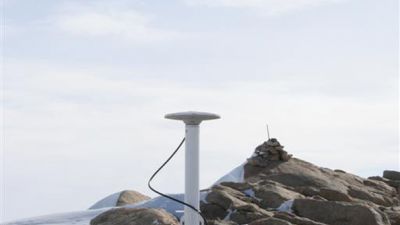
Research at the Princess Elisabeth Station: GIANT
Lead by the Royal Observatory of Belgium and in collaboration with the University of Luxembourg and the Royal Military Academy, the Geodesy In ANTarctica (GIANT) project was launched at the Princess Elisabeth Antarctica station in February 2009. Since then, much has happened, including first result analysis back in Belgium. By combining GPS data, gravimetry and seismology techniques, GIANT will trace the horizontal and vertical deformation of the Earth's surface and focus on the relation between ice mass variation and crust deformation in the Polar Regions.
The first BELARE 2008-09 season was an opportunity to test the GPS installation as well as the instruments' precision for tectonic and atmospheric studies in the Polar Regions. By working with these variables, GIANT intends on improving scientific knowledge about land mass changes since the last glacial period and climate-related mechanisms, but also to increase our understanding about climate change.
Instrumentation
Glaciers deform the Earth's crust by either gaining or losing ice mass. Two phenomena have been causing deformation in Antarctica: the first one is rather slow and began10,000 years ago when the ice started to melt at the end of the last ice age; the second is a lot faster and is caused by current climate change. In order to quantify each component separately, it is necessary to combine measurements of surface deformation from GPS data with measurements of variations in gravity using an absolute gravimeter.
During the BELARE 2008-09 field expedition, Nicolas Bergeot from the Royal Observatory of Belgium (ROB) was in charge of setting up two GPS stations in the vicinity of the Princess Elisabeth research station. The GPS stations make it possible to estimate variations in position due to horizontal and vertical crust motions at a sub-mm/yr precision level. The main reason for installing two GPS stations is to make it possible to compare results and to detect any monitoring errors -for example, if one of the antennas moved due to slippage of unstable bedrock.
During the first scientific season at the Princess Elisabeth Station, Nicolas Bergeot had to choose a suitable spot to install the GPS antenna (stable rocks, good reception from the GPS satellites). This was the hardest part, considering the numerous granitic rocks found on Utseinen Ridge. Working with two technicians from the station, it took the trio two full days to install all the equipment, connect the cables between the receivers and the antenna and set the fuel generator to power the GPS receivers in one of the two scientific shelters.
After two full days of setting up equipment, the GPS was ready to collect data, and it did for four consecutive days. The data were then processed and validated by seven other GPS stations in Antarctica so as to calibrate the ability of the GPS station to calculate atmospheric parameters.
BELARE 2008-2009 Results
GPS Positioning
The position and precision of the two GPS stations were tested both on horizontal and vertical planes. Initial results revealed just how precise the GPS instruments were. Scientists are ambitious about the ability of the GPS stations to constrain models about land mass changes during the last glacial period in Antarctica.
Preliminary Atmospheric Results
The GPS data was also used to better understand the physics of the atmosphere in Antarctica. As satellite signals cross the atmosphere to reach the GPS antenna located on Earth, they are refracted in the atmosphere. The two layers of the atmospheric that affect GPS signals the most are the troposphere and the ionosphere. Refraction caused by these two layers can be used to quantify a certain amount of atmospheric parameters (quantity of water vapor in the atmosphere and electron density of the ionosphere).
Tropospheric refraction, for example, can tell scientists about water vapour content which, in turn, can indicate to climatologists, whether there will be any long-term variation. First tests and analyses revealed sufficient precision for meteorological applications and, in the future, also for climatological studies.
Ionospheric refraction, on the other hand, is of primary interest to space weather research and the detection of electromagnetic propagation disturbance (ex: radio waves can be used to measure electron density in the ionosphere). Preliminary results encourage continuous ionospheric monitoring close to the station over the next coming years in order to better understand the physics of the ionosphere and to refine models of the ionosphere in the Polar Regions.
Future Perspectives at the Princess Elisabeth Station
The four days of continuous data acquired during BELARE 2008-09 made it possible to successfully estimate the precision (<5 mm on horizontal and vertical components) that would be obtained from the instruments at and near Utsteinen. With such figures, the ROB expects to calculate first velocities of crust variation during the next scientific season 2009-2010.
Another significant challenge over the next coming years will be monitoring the atmosphere in the Polar Regions. Indeed, the high-precision GPS installation makes it possible to conduct atmospheric studies using the same antennas.
Picture: International Polar Foundation - © International Polar Foundation
